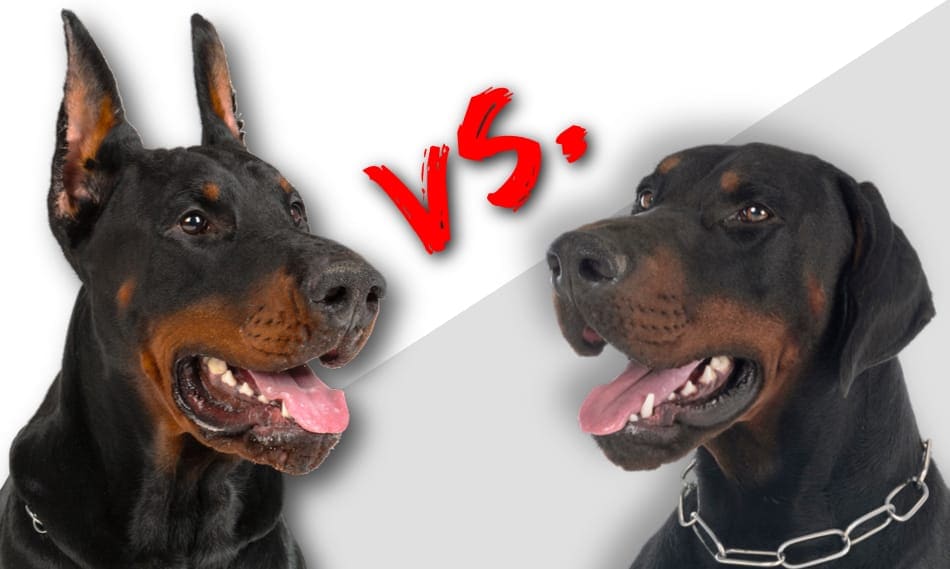When it comes to the question of whether or not to crop Doberman ears, there are strong opinions on both sides. Some argue that ear cropping is a necessary procedure to preserve the traditional look of the breed, while others believe it is an unnecessary and potentially cruel practice. So, what’s the truth behind cropping Doberman ears?
Ear cropping has a long history in the Doberman breed. Originally, it was believed that cropping the ears would make the dogs more effective guard dogs by reducing the surface area of the ear that could be grabbed during an attack. However, there is no scientific evidence to support this claim. In fact, many countries and organizations, such as the American Veterinary Medical Association, have come out against ear cropping, stating that it is purely cosmetic and serves no practical purpose. As a result, the practice has been banned or heavily regulated in several countries. Today, the decision to crop a Doberman’s ears is largely a personal choice made by the owner.
Cropping Doberman ears is a personal decision and should be discussed with a professional veterinarian. While some owners choose to crop their Doberman’s ears for aesthetic reasons, it is not a requirement. Cropping is a surgical procedure that involves removing a portion of the ear and shaping it. It’s important to consider the potential risks and benefits before making a decision. Consult with a qualified veterinarian who can provide guidance based on your specific circumstances and the breed’s standards.

Are You Supposed to Crop Doberman Ears?
The practice of cropping dog ears, including those of Dobermans, is a controversial topic. Some people argue that ear cropping is necessary for health and aesthetic reasons, while others believe it is unnecessary and unethical. In this article, we will explore the question of whether you are supposed to crop Doberman ears and provide you with detailed information to help you make an informed decision.
History of Ear Cropping in Dobermans
Ear cropping has a long history, and it is believed to have been practiced on Dobermans for both functional and aesthetic reasons. Historically, the primary purpose of cropping a Doberman’s ears was to prevent injuries during their work as guard dogs and to enhance their appearance. The cropped ears were thought to make the dog appear more alert and intimidating.
Over time, the practice of ear cropping has become more controversial. Some countries have banned the procedure altogether, while others permit it but with certain restrictions and regulations. The decision to crop a Doberman’s ears is a personal choice and should be made after considering various factors.
Arguments in Favor of Ear Cropping
Proponents of ear cropping argue the following reasons:
- Health Benefits: Some believe that ear cropping can prevent ear infections and reduce the risk of ear injuries, especially in working Dobermans or those engaged in activities that could result in ear damage.
- Breed Standards: In certain dog shows and competitions, Dobermans with cropped ears may receive higher scores and be considered more accurate representations of the breed’s standard.
- Historical Tradition: Ear cropping has been a longstanding tradition in some countries and has been practiced for generations, so it is considered part of the breed’s identity.
| Pros of Ear Cropping |
| Health Benefits |
| Breed Standards |
| Historical Tradition |
Arguments Against Ear Cropping
Opponents of ear cropping present the following arguments:
- Ethical Concerns: Many consider ear cropping to be a form of unnecessary cosmetic surgery that causes pain, discomfort, and potential complications for the dog.
- Health Risks: The ear cropping procedure itself carries risks, including infection, bleeding, anesthesia-related complications, and improper healing.
- Changing Perceptions: Society’s views on ear cropping have shifted, and many people now prefer the natural appearance of uncropped ears.
| Cons of Ear Cropping |
| Ethical Concerns |
| Health Risks |
| Changing Perceptions |
Making an Informed Decision
The decision to crop a Doberman’s ears should be made after careful consideration and consultation with a veterinarian. It is essential to weigh the potential benefits against the risks and ethical concerns. If you are considering ear cropping, make sure you research your local laws and regulations regarding the procedure, as it may be illegal or restricted in certain areas.
Remember that the appearance of a Doberman’s ears does not determine their health, temperament, or ability to be a loving and loyal companion. Ultimately, whether or not you choose to crop your Doberman’s ears is a personal decision that should prioritize their well-being and happiness.
Should You Crop Your Doberman’s Ears?
Deciding whether to crop a Doberman’s ears can be a complex and personal choice. It is important to consider both sides of the argument and consult with professionals before making a decision. Here are three key factors to consider:
1. Health and Safety
While some argue that ear cropping can prevent certain health issues, such as ear infections and injuries, it is crucial to note that these claims are not universally supported by scientific evidence. Dogs with natural, uncropped ears can also lead healthy and fulfilling lives.
Furthermore, the ear cropping procedure itself carries potential risks, including pain, complications, and the need for anesthesia. It is essential to carefully consider the potential health benefits versus the risks involved in the procedure.
2. Aesthetics and Breed Standards
Dobermans with cropped ears may fulfill certain breed standards and criteria for dog shows and competitions. However, it is important to remember that breed standards can evolve, and the natural appearance of uncropped ears is becoming more widely accepted.
3. Personal Values and Ethics
Your personal values and ethics should play a significant role in the decision-making process. Consider your beliefs regarding unnecessary cosmetic procedures on animals and whether or not you feel ear cropping aligns with your values.
If you decide to pursue ear cropping, it is crucial to work with a reputable and experienced veterinarian who can provide proper care and perform the procedure safely. Take the time to research local laws and regulations regarding ear cropping, as it may be illegal or restricted in some areas.
Key Takeaways
- Cropping a Doberman’s ears is a personal decision and not a requirement.
- Cropping can be done for cosmetic reasons or to adhere to breed standards.
- The procedure involves surgically removing a portion of the ear to shape it.
- Cropping must be done by a professional veterinarian to ensure proper healing.
- Uncropped ears can still be healthy and do not affect the dog’s quality of life.
Frequently Asked Questions
Cropping the ears of Doberman Pinschers is a topic that often generates discussions and opinions. Here are some frequently asked questions regarding cropping Doberman ears.
1. Should I crop my Doberman’s ears?
Cropping a Doberman’s ears is a personal decision that depends on various factors, including personal preference, breed standards, and the intended use of the dog. Ear cropping is mainly done for cosmetic purposes, giving the dog a more alert and regal appearance. It is essential to consult with a professional veterinarian and research the breed standards and applicable laws in your area before making a decision.
It is important to note that ear cropping is a surgical procedure that involves removing a portion of the ear flap and redirecting blood flow to promote standing ears. The procedure should only be performed by a trained and experienced veterinarian to ensure the safety and well-being of the dog.
2. What are the benefits of cropping Doberman ears?
The primary benefit of cropping a Doberman’s ears is purely aesthetic. Many Doberman enthusiasts prefer the cropped ear look as it enhances the breed’s characteristics and gives them a more distinct appearance. It can also potentially reduce the risk of ear infections since cropped ears allow for better air circulation.
However, it is important to note that ear cropping solely for cosmetic reasons is a personal preference and not a requirement for owning a Doberman. It is essential to consider the potential risks and aftercare involved in the procedure before making a decision.
3. Are there any risks associated with cropping Doberman ears?
Like any surgical procedure, there are risks involved in cropping a Doberman’s ears. These risks can include infection, excessive bleeding, unsatisfactory outcome, and prolonged healing time. It is crucial to choose a reputable veterinarian who specializes in ear cropping and follow their aftercare instructions diligently to minimize the risks and promote proper healing.
Furthermore, it is essential to consider that ear cropping is a procedure performed under general anesthesia, which carries its own set of risks. Discuss the procedure thoroughly with the veterinarian and ask about their experience and success rates to make an informed decision.
4. Can Dobermans have natural, uncropped ears?
Absolutely! Many Doberman owners choose to keep their dog’s ears natural and uncropped. Natural ears can still exhibit the distinctive Doberman appearance while eliminating the risks and aftercare associated with ear cropping. It is a personal choice, and natural ears do not affect the health or temperament of the dog.
5. Is ear cropping legal?
The legality of ear cropping varies depending on the country, state, or region. In some places, ear cropping is strictly regulated and may only be performed by licensed veterinarians for specific purposes such as breed standards or working dogs. It is crucial to research and understand the laws and regulations regarding ear cropping in your area before considering the procedure.
Remember to consult with a professional veterinarian who is knowledgeable about the specific regulations in your region to ensure compliance with the law and the well-being of your Doberman.

Doberman Pinscher Ear Cropping: What’s it Like?
In summary, cropping a Doberman’s ears is a personal choice and not necessary for their health or well-being.
Ear cropping involves surgical cutting and reshaping of the ears, and it is done primarily for cosmetic purposes. However, it can cause pain, infection, and other complications.
